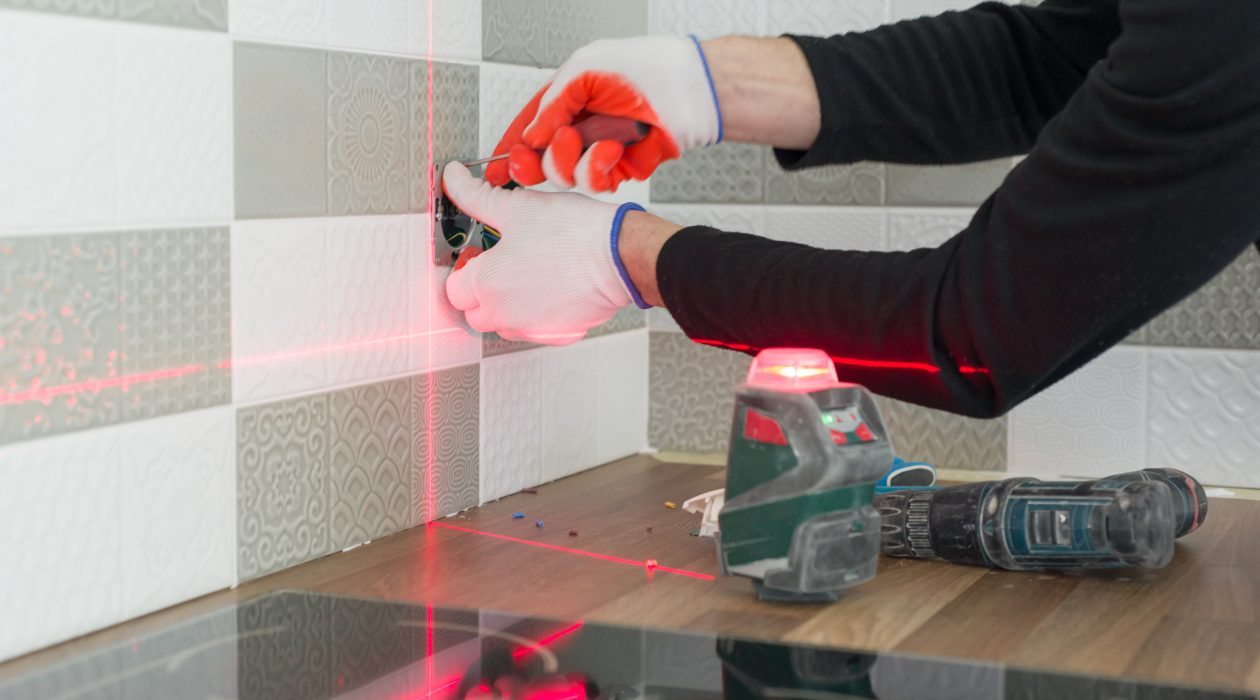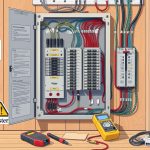Welcome to our comprehensive guide to laser levels. Here, we’ll dive into the world of laser levels and show you how to use them for precise projects. Whether you’re a DIY enthusiast or a professional contractor, this article will offer valuable insights. It aims to make our laser level guide easy to follow, ensuring you get the most out of your laser levels.
In this article, we’ll discuss the benefits and features of laser levels, along with their applications in various projects. By the end of this guide, you’ll know how to choose the right laser level for your needs. You’ll also learn to use it with confidence. So, let’s start our journey into the world of laser levels.
Key Takeaways
- Understand the basics of laser levels and how they work
- Learn about the different types of laser levels available
- Discover the key features to look for in a laser level
- Get tips on how to use laser levels for precise projects
- Learn how to maintain and care for your laser level
- Understand the importance of safety considerations when using laser levels
Understanding Laser Levels: The Basics of Modern Measurement
Laser levels have become crucial tools for precision in fields like construction, engineering, and surveying. They project a level line or point using a laser beam. This allows for accurate measurement and alignment of objects.
The concept behind laser levels is leveling. It involves determining an object’s position relative to a reference plane. Laser levels make it easy to check the levelness of surfaces, making them vital for precise projects.
What is a Laser Level?
A laser level emits a laser beam that projects a level line or point onto a surface. This line or point acts as a reference. It enables users to measure and align objects with great accuracy.
How Laser Levels Work
Laser levels use a laser diode to emit a beam. This beam is reflected by a rotating mirror, creating a level line or point. The beam is then projected onto a surface, allowing for precise measurement and alignment.
The Evolution of Leveling Technology
Leveling technology has evolved significantly, leading to more accurate laser levels. Modern models come with features like automatic leveling and tilt compensation. These advancements make laser levels essential for precise work.
Understanding laser levels and their functionality highlights their importance. Whether you’re a professional or a DIY enthusiast, a laser level is vital. It offers high accuracy and reliability for any precision project.
Types of Laser Levels Available Today
In the realm of laser levels, the market offers a variety of models, each with distinct features and uses. Grasping these differences is essential for picking the perfect laser level guide for your endeavor. The array of choices, from rotary to line laser levels, might seem daunting. Yet, with the right insights, you can make a well-informed choice.
A laser level guide aids in distinguishing between dot, cross line, and rotary laser levels. Each variety excels in certain tasks and projects. For example, rotary laser levels are perfect for big construction projects. On the other hand, line laser levels are more suitable for smaller tasks like setting up shelves or cabinets.
When selecting a laser level, accuracy, range, and durability are critical factors. It’s also important to consider the project’s nature and the precision needed. With the right laser level guide, your project will be completed efficiently and accurately.
Here are some of the most common types of laser levels:
- Dot laser levels
- Cross line laser levels
- Rotary laser levels
- Line laser levels
By familiarizing yourself with the various laser levels and their applications, you can select the ideal tool for your project. This ensures you achieve professional-grade outcomes.
Essential Features to Look for in Laser Levels
Choosing the right laser level for your project involves several key features. A laser level must offer accurate measurements and reliable results. We will discuss the essential features, including accuracy ratings, battery life, range, and visibility. Durability and weather resistance are also crucial.
Accurate measuring tools are vital for professional-grade results. A laser level with high accuracy ratings ensures precise measurements. It should also have a long battery life and suitable power options, like rechargeable batteries or a long-lasting power source.
Range and visibility are important, determining how far and clearly the laser beam can be seen. Durability and weather resistance are also essential. They ensure your laser level withstands various environmental conditions and lasts long. By considering these features, you can find a laser level that meets your needs and provides accurate results.
Accuracy Ratings Explained
Accuracy ratings are a critical factor in choosing a laser level. A high accuracy rating means your measurements will be precise and reliable. Look for a laser level with an accuracy rating that suits your needs, such as ±1/8 inch or ±1/16 inch.
Battery Life and Power Options
Battery life and power options are also key considerations. A laser level with a long battery life ensures uninterrupted use. Opt for a laser level with rechargeable batteries or a long-lasting power source, like a lithium-ion battery.
Setting Up Your Laser Level for Perfect Results
To maximize your laser level’s performance, proper setup is crucial. A laser level guide can aid in grasping the fundamental setup and operation principles. Ensure your laser level rests on a stable surface and is calibrated accurately.
Here are some essential tips to consider:
- Opt for a flat and level surface for your laser level.
- Follow the manufacturer’s guidelines to calibrate your laser level.
- Utilize a laser level guide for precise measurements.
By adhering to these guidelines and using your laser levels effectively, you’ll achieve the exact results needed for your projects. Always consult your laser level’s user manual for detailed setup and operation instructions.
Indoor Applications and Best Practices
In indoor projects, a laser level is indispensable for precision, leading to professional outcomes. It’s vital for tasks like installing cabinets, drop ceilings, or tile, where accuracy is key. This ensures a successful project.
Common indoor uses for laser levels include:
- Cabinet installation: ensuring cabinets are level and plumb is crucial for a secure and functional installation.
- Drop ceiling installation: a laser level helps you create a level and even grid for your drop ceiling tiles.
- Wall tiling projects: with a laser level, you can easily create a level line for your tiles, ensuring a straight and even installation.
Using a laser level for precision in indoor projects guarantees accurate and easy completion. Always rely on accurate measuring tools for the best results.
With the right tools and practice, you can confidently handle complex indoor projects. You’ll achieve professional-looking results that will stand the test of time.
Outdoor Construction and Landscaping Uses
In outdoor construction and landscaping, laser levels are crucial for precise results. A laser level guide is vital for mastering these tools in various outdoor settings.
Outdoor uses of laser levels include:
- Grading and excavating land
- Installing outdoor lighting and electrical systems
- Building decks and patios
- Creating retaining walls and other landscaping features
Utilizing laser levels in these tasks ensures efficient and accurate project completion.
For instance, when constructing a deck, a laser level helps maintain level and plumb surfaces. It also ensures posts are evenly spaced. This prevents errors, making the deck safe and durable.
Employing laser levels in outdoor projects can significantly reduce costs and time. It also enhances the quality of your work, achieving professional standards.
Professional Tips for Maximum Accuracy
To get the best out of laser levels, it’s crucial to use precise tools and follow expert advice. Calibration is key to ensuring accuracy. It involves adjusting the laser level to be perfectly level and plumb. This provides a reliable base for measurements.
Environmental factors also impact accuracy. Temperature, humidity, and dust can alter laser level performance. Working in a controlled environment helps reduce errors and ensures precise measurements. Key environmental factors include:
- Avoiding direct sunlight, which can disrupt the laser beam
- Reducing dust and debris to improve measurement accuracy
- Keeping a consistent temperature, as extreme temperatures can impair the laser level’s function
By adhering to these guidelines and employing precise tools, users can achieve top-notch accuracy.
| Calibration Technique | Environmental Consideration | Common Mistake to Avoid |
|---|---|---|
| Regularly check and adjust the laser level | Avoid direct sunlight | Not calibrating the laser level before use |
| Use a reference point for calibration | Maintain a consistent temperature | Not accounting for environmental factors |
Being mindful of these common pitfalls and taking steps to circumvent them ensures accurate and dependable measurements. This makes projects more successful. The use of precise tools and a tool for precision is essential for achieving professional-grade results.
Maintaining and Caring for Your Laser Level
To keep your laser level guide accurate, proper maintenance is key. Regular upkeep extends its lifespan and prevents downtime. A well-maintained laser level is vital for precise projects. By following simple tips, you can ensure your tool remains in optimal condition.
Cleaning and storage are crucial for laser level care. Store your laser level in a dry, cool spot, away from sunlight. Use a soft cloth for cleaning and avoid harsh chemicals or extreme temperatures. This protects the laser and ensures its accuracy.
Cleaning and Storage Tips
- Use a soft, dry cloth to clean the laser level
- Avoid exposing the device to harsh chemicals or extreme temperatures
- Store the laser level in a dry, cool place, away from direct sunlight
By adhering to these maintenance tips, you can prolong your laser level’s life. Always check your laser level guide for specific care instructions, as models vary. Proper care ensures accurate results and efficient project completion.
Troubleshooting Common Laser Level Issues
Using a tool for precision like a laser level requires knowing how to tackle common problems. Inaccurate readings often stem from faulty batteries or damaged parts. To fix this, replace the batteries or inspect the level’s components for damage.
Another frequent issue is the laser level failing to turn on. This might be due to a dead battery or a malfunctioning power button. Attempt to charge the battery or replace it if needed. If the problem continues, refer to the user manual or reach out to the manufacturer for help. Ensuring your laser level works accurately is vital for quality work.
To avoid delays and ensure your laser level’s accuracy, it’s crucial to address issues promptly. Here are some troubleshooting tips:
- Check the level’s components for any damage
- Replace the batteries if they are dead or faulty
- Consult the user manual or contact the manufacturer for assistance
Comparing Budget vs Professional Laser Levels
When selecting a laser level, budget is a key consideration. Prices vary widely, from affordable entry-level models to high-end professional tools. It’s essential to understand the differences to make an informed choice. A detailed laser level guide can help you compare features and prices effectively.
Entry-Level Options
Entry-level laser levels are ideal for small DIY projects or occasional use. They feature basic functions and are more affordable. Some notable entry-level options include:
- Point lasers for simple leveling tasks
- Line lasers for basic alignment and layout
- Combination lasers for both point and line functionality
Mid-Range Choices
Mid-range laser levels provide more advanced features and better accuracy than entry-level models. They are suitable for larger projects or frequent use. Mid-range options often include:
- Rotary lasers for 360-degree coverage
- Self-leveling lasers for increased accuracy
- Laser levels with adjustable brightness and visibility
Professional-Grade Equipment
Professional-grade laser levels are designed for heavy-duty use, offering the highest accuracy and features. They are perfect for large-scale construction projects or for professional contractors. When choosing a laser level, consider your specific needs and budget. This will help you find the best option from a reliable laser level guide.
Safety Considerations and Best Practices
When using laser levels, safety is paramount to prevent accidents and ensure project success. Employing accurate measuring tools can greatly lower error risks and enhance safety. A tool for precision like a laser level demands careful handling and adherence to safety protocols.
To mitigate risks, consider these safety measures:
- Wear protective eyewear to prevent eye damage from the laser beam
- Ensure tripod stability to prevent the laser level from falling or being damaged
- Be aware of environmental hazards, such as dust or moisture, that can affect the laser level’s accuracy
By adhering to these guidelines and utilizing accurate measuring tools and a tool for precision, you can establish a safe workspace. This approach ensures professional-grade outcomes. Always prioritize safety when working with laser levels.
Conclusion: Making the Most of Your Laser Level Investment
This comprehensive laser level guide has shown how these tools can transform your projects. They bring precision and speed to home improvements and construction. With a quality laser level, you’ll get accurate measurements and perfect alignment. This means you can work with more confidence and efficiency.
Whether you’re a DIY novice or a seasoned pro, this article has given you valuable insights. You now know how to use your laser level to its fullest potential. From setting up cabinets to landscaping, you’re ready to achieve exceptional results.
Investing time in learning your laser level and keeping it in top shape is crucial. It ensures you get the most out of this vital tool. With proper use, your laser level will become a key part of your work. It will improve the quality and consistency of your projects for years.


